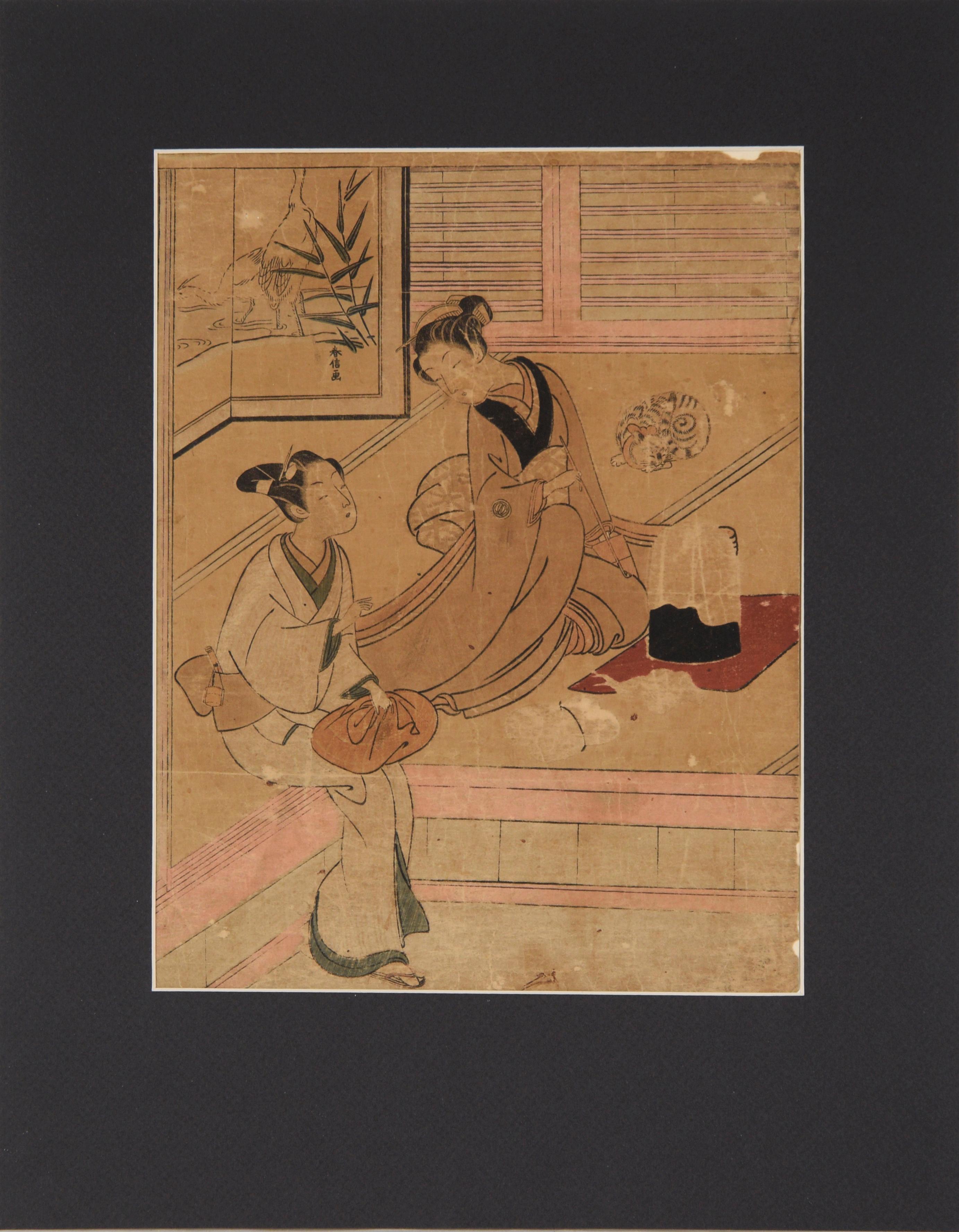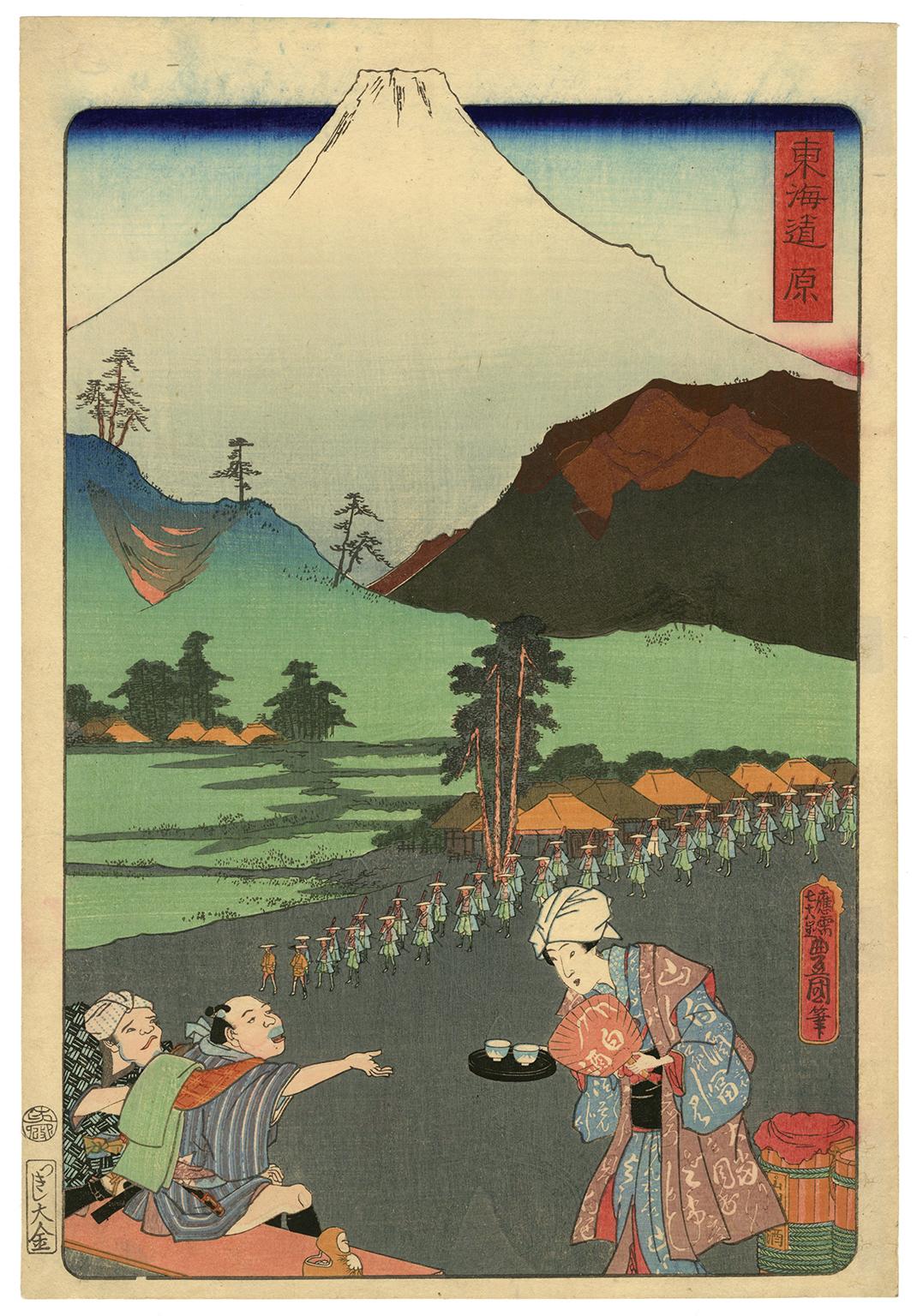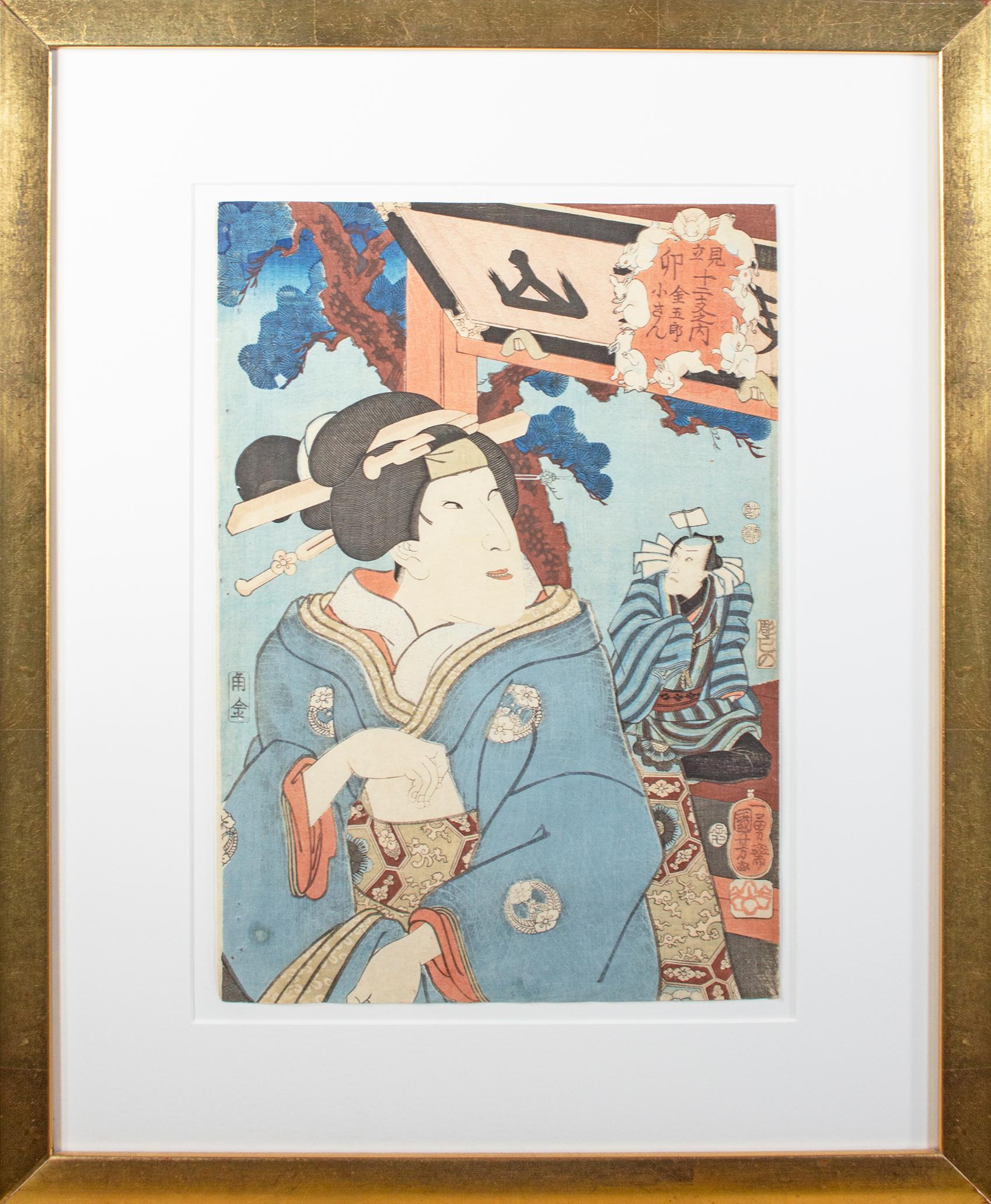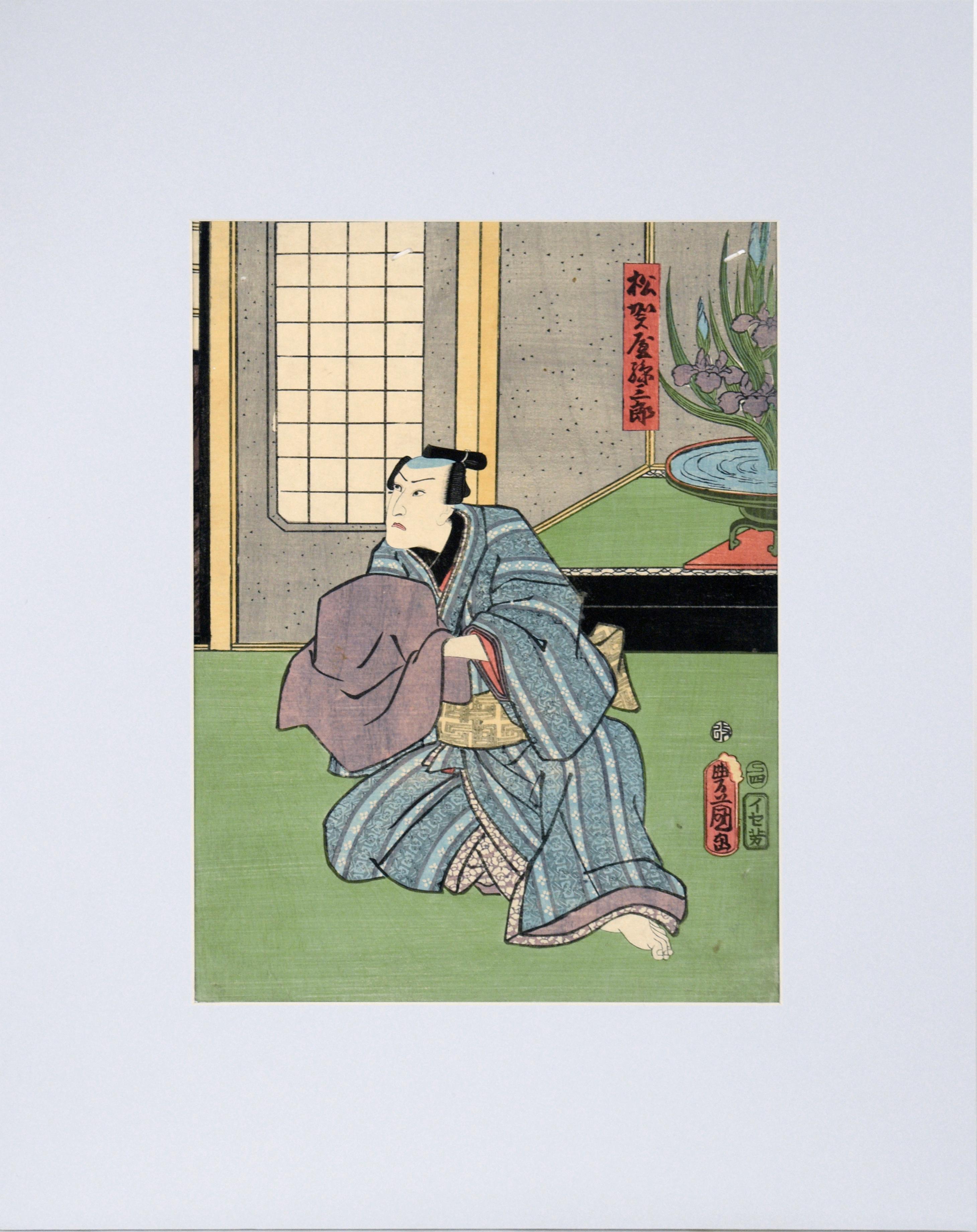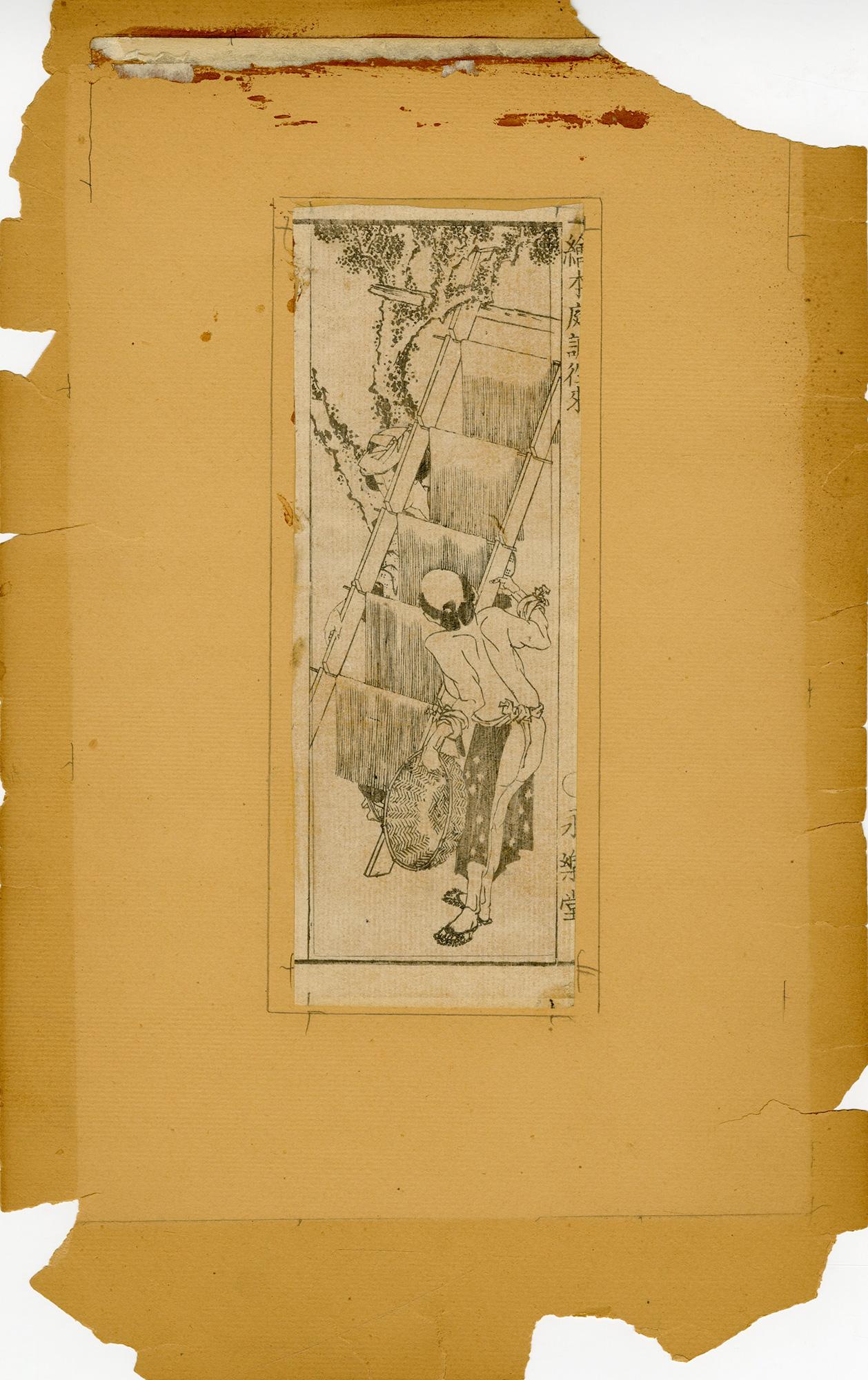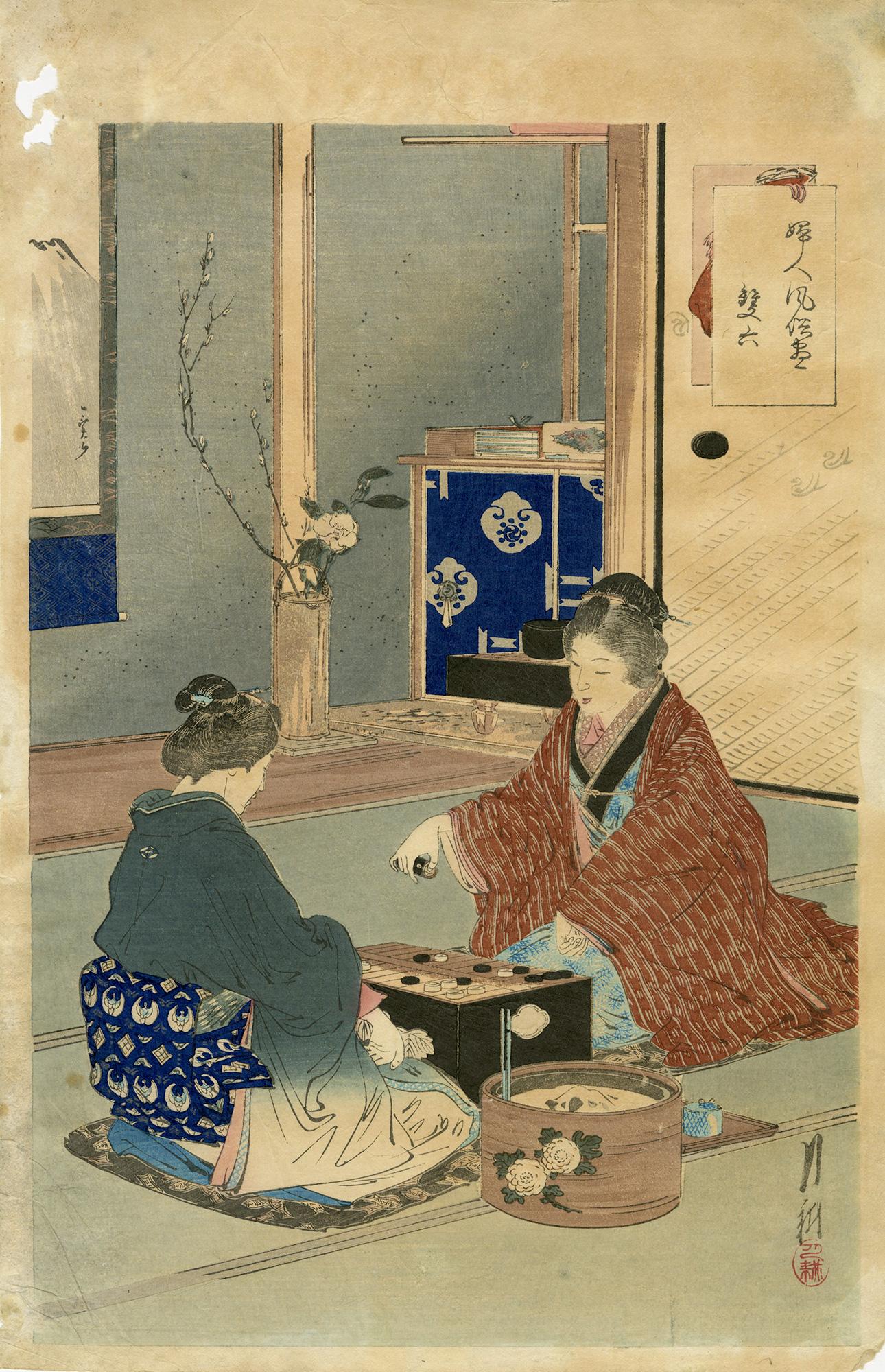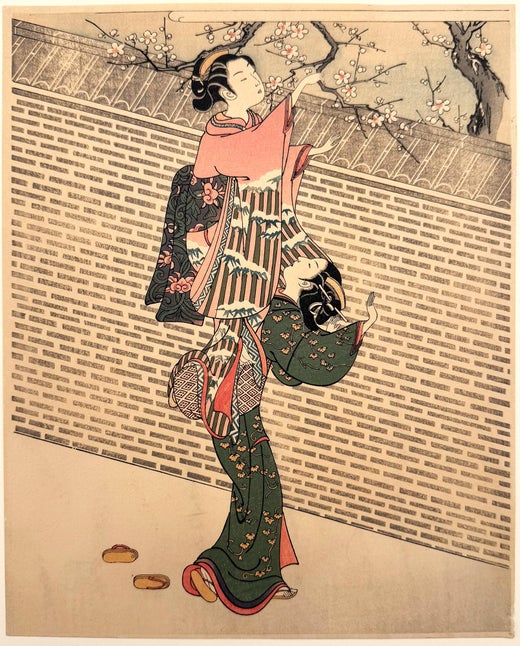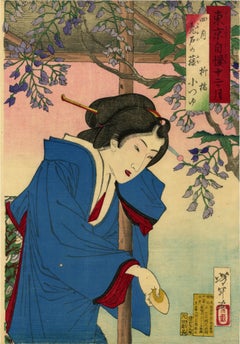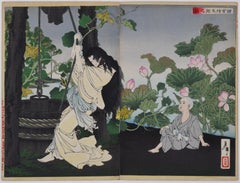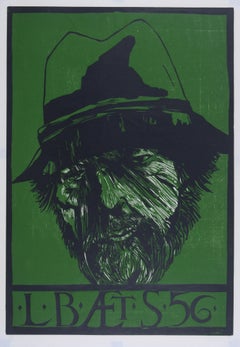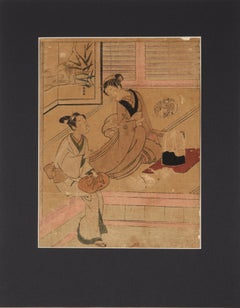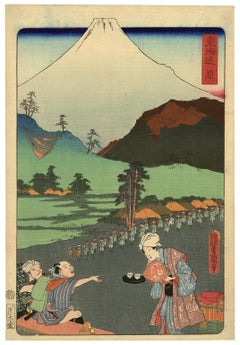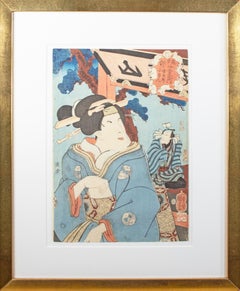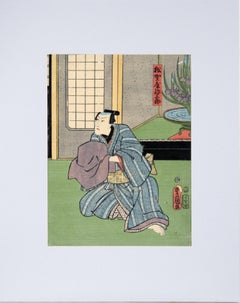Items Similar to Beauty on a Veranda with Fan and Mirror
Want more images or videos?
Request additional images or videos from the seller
1 of 8
Suzuki (Hozumi) HarunobuBeauty on a Veranda with Fan and Mirror1769-1770
1769-1770
About the Item
Signed: Harunobu ga
Series: Series: Eight Fashionable Parlor Views (Furyu zashiki hakkei)?
Format Japanese: chuban
Provenance:
Private Collection, Philadelphia
Collection of McCleaf
Condition: Colors slightly faded, sheet with centerfold, trimmed and backed
Sheet size: 6 3/4 x 10 7/16 inches
- Creator:Suzuki (Hozumi) Harunobu (1724-1770, Japanese)
- Creation Year:1769-1770
- Dimensions:Height: 6.75 in (17.15 cm)Width: 10.438 in (26.52 cm)
- Medium:
- Movement & Style:
- Period:
- Condition:Colors slightly faded, sheet with centerfold, trimmed and backed.
- Gallery Location:Fairlawn, OH
- Reference Number:Seller: UK20601stDibs: LU14013160622
Suzuki (Hozumi) Harunobu
Suzuki Harunobu (Japanese: 鈴木 春信; c. 1725 – 8 July 1770) was a Japanese designer of woodblock print art in the ukiyo-e style. He was an innovator, the first to produce full-color prints (nishiki-e) in 1765, rendering obsolete the former modes of two- and three-color prints. Harunobu used many special techniques, and depicted a wide variety of subjects, from classical poems to contemporary beauties. Like many artists of his day, Harunobu also produced a number of shunga, or erotic images. During his lifetime and shortly afterwards, many artists imitated his style. A few, such as Harushige, even boasted of their ability to forge the work of the great master. Much about Harunobu's life is unknown.
About the Seller
5.0
Recognized Seller
These prestigious sellers are industry leaders and represent the highest echelon for item quality and design.
Platinum Seller
Premium sellers with a 4.7+ rating and 24-hour response times
Established in 1978
1stDibs seller since 2013
787 sales on 1stDibs
Typical response time: <1 hour
Associations
International Fine Print Dealers Association
- ShippingRetrieving quote...Shipping from: Fairlawn , OH
- Return Policy
Authenticity Guarantee
In the unlikely event there’s an issue with an item’s authenticity, contact us within 1 year for a full refund. DetailsMoney-Back Guarantee
If your item is not as described, is damaged in transit, or does not arrive, contact us within 7 days for a full refund. Details24-Hour Cancellation
You have a 24-hour grace period in which to reconsider your purchase, with no questions asked.Vetted Professional Sellers
Our world-class sellers must adhere to strict standards for service and quality, maintaining the integrity of our listings.Price-Match Guarantee
If you find that a seller listed the same item for a lower price elsewhere, we’ll match it.Trusted Global Delivery
Our best-in-class carrier network provides specialized shipping options worldwide, including custom delivery.More From This Seller
View AllThe Heroine Umekawa in "Meido no Kiyaku"
Located in Fairlawn, OH
Title: The Heroine Umekawa in "Meido no Kiyaku"
Medium: Color woodcut with mica background, silver metallic pigment, and "gofun" for the snow effect
Date Of Execution: 1923
Dimension...
Category
1920s Edo Figurative Prints
Materials
Woodcut
April: Otsuyu of Yanagibashi in Wisteria Arbor at Kameido
By Taiso Yoshitoshi
Located in Fairlawn, OH
April: Otsuyu of Yanagibashi in Wisteria Arbor at Kameido
Color woodcut, 1880
From the series: "Pride of Tokyo's Twelve Months" (Tokyo jiman juni kagetsu)
Signed and sealed lower rig...
Category
1880s Other Art Style Figurative Prints
Materials
Woodcut
The Story of Tamiya Bataro
By Taiso Yoshitoshi
Located in Fairlawn, OH
The Story of Tamiya Bataro
Color woodcut diptych, March 22, 1886
Signed and sealed by the artist (see photo) Yoshitoshi signature, Taiso seal
Series: New selection of eastern brocad...
Category
1880s Figurative Prints
Materials
Woodcut
Self Portrait-L.B. AET 56
By Leonard Baskin
Located in Fairlawn, OH
Self Portrait-L.B. AET 56
Color woodcut printed in black and green, 1978
Signed in pencil lower right (see photo)
Edition: 150 (97/150)
Condition: Excellent
Image: 32 x 22”
Sheet: 35...
Category
1970s American Modern Figurative Prints
Materials
Woodcut
No Footprints Show, Where the Flowers Grow Deep
By Shiko Munakata
Located in Fairlawn, OH
No Footprints Show, Where the Flowers Grow Deep
Woodcut, 1961
Unsigned (as isssued)
From: The "Way" of the Woodcut, three woodcuts, 1961
Publisher: Pratt Adlib Press, Brooklyn, New Y...
Category
1960s Modern Figurative Prints
Materials
Woodcut
Shunga: Twelve Signs of the Zodiac - Goat
Located in Fairlawn, OH
Shunga: Twelve Signs of the Zodiac - Goat
Color woodcut with gauffrage (embossing)
Unsigned (as usual)
Format: Shikishiban
Publisher: Privately produced
Unusually well preserved with the fugitive blue still intact
Image size: 5-1/8 x 5-3/4"
Sheet size: 5 3/8 x 6 1/4"
From Wikipedia, the free encyclopedia
In this Japanese name, the surname is Isoda.
Isoda Koryūsai (礒田 湖龍斎, 1735–1790) was a Japanese ukiyo-e print designer and painter active from 1769 to 1790.
Life and career
Koryūsai was born in 1735 and worked as a samurai in the service of the Tsuchiya clan. He became a masterless rōnin after the death of the head of the clan and moved to Edo (modern Tokyo) where he settled near Ryōgoku Bridge in the Yagenbori area. He became a print designer there under the art name Haruhiro in 1769, at first making samurai-themed designs. The ukiyo-e print master Harunobu died in 1770, and about that time Koryūsai began making prints in a similar style of life in the pleasure districts.
Koryūsai was a prolific designer of individual prints and print series,[1] most of which appeared between 1769 and 1881.
In 1782, Koryūsai applied for and received the Buddhist honour hokkyō ("Bridge of the Law") from the imperial court and thereafter used the title as part of his signature. His output slowed from this time, though he continued to design prints until his death in 1790.
Works
Koryūsai created a total of 2,500 known designs, or an average of four a week. According to art historian Allen Hockley, "Koryūsai may ... have been the most productive artist of the eighteenth century".
The series Models for Fashion: New Designs as Fresh Young Leaves (Hinagata wakana no hatsumoyō, 1776–1781) ran for 140 prints, the longest known ukiyo-e print series of beauties. He designed at least 350 hashira-e pillar prints, numerous kachō-e bird-and-flower prints, a great number of shunga erotic prints, and others. Ninety of his nikuhitsu-ga paintings are known, making him one of the most productive painters of the period.
Legacy
Despite Koryūsai's productivity and popularity—both in his time and amongst later collectors—his work has attracted little scholarship. The first ukiyo-e histories written in the West in the 19th century elevated certain artists as exemplars; Koryūsai's work came to be seen as too indebted to Harunobu, who died in 1770, and inferior to that of Kiyonaga, whose peak period came in the 1880s. An example is Woldemar von Seidlitz's Geschichte des japanischen Farbenholzschnittes ("History of Japanese colour prints", 1897), the most popular of the early ukiyo-e histories, which paints Koryūsai as a successor to Harunobu and a rival of Kiyonaga in the 1770s who slipped into mediocrity and imitation of his rival by the end of the decade.[5] Interest lay mainly in the details of Koryūsai's life—a samurai who received court honours was unusual in the proletarian world of ukiyo-e. In 2021, contemporary woodblock printmaker David Bull...
Category
1770s Other Art Style Figurative Prints
Materials
Woodcut
You May Also Like
Japanese Original Woodblock Print
Located in Soquel, CA
Japanese Original Woodblock Print
Harunobu Suzuki (né Hozumi) (Japanese, 1724 - 1770)
Presented in a black mat.
Mat: 16"H x 12"W
Paper: 12"H x 9"W
I...
Category
18th Century Edo Figurative Prints
Materials
Ink, Rice Paper, Woodcut
'Tokaido' — Mt. Fuji Rising – Mid-Nineteenth Century Woodblock Print
By Utagawa Kunisada (Toyokuni III)
Located in Myrtle Beach, SC
Utagawa Kunisada (Tokoyuni III), 'Tokaido', color woodblock, 1863. Signed in the cartouche, lower right. A fine impression, with rich, fresh colors and pronounced woodgrain, the full...
Category
1860s Edo Figurative Prints
Materials
Woodcut
19th century color woodcut Japanese ukiyo-e print female geisha figure signed
By Utagawa Kuniyoshi
Located in Milwaukee, WI
This print is from a highly regarded series by the Edo woodblock artist Utagawa Kuniyoshi: in the period, there were at times prohibitions in depicting a...
Category
1850s Edo Figurative Prints
Materials
Paper, Pigment, Woodcut
"Sun Saburo Matsugaya" - Mid 19th Century Figurative Japanese Woodblock Print
By Utagawa Kunisada (Toyokuni III)
Located in Soquel, CA
"Sun Saburo Matsugaya" - Mid 19th Century Figurative Japanese Woodblock Print
Beautiful mid 19th century figural Japanese woodblock print of a seated man with lilies in the background by Utagawa Toyokuni III (Kunisada) (Japanese, 1786-1864/5). Artist's chop is in the lower right corner of the piece. The actor is Magosaburo Matsugaya from the play "Katakiuchi Rumors"
Presented in a new grey-blue mat with foamcore backing.
Mat size: 21"H x 16"W
Paper size: 14"H x 9.75"W
During his lifetime Kunisada Utagawa...
Category
1850s Edo Figurative Prints
Materials
Paper, Ink, Woodcut
Drying Paper
Located in Middletown, NY
Woodcut on cream laid paper, 7 1/4 x 2 1/2 inches (182 x 63 mm), narrow margins. Laid down to non-archival board with scattered soiling and some adhesive staining.
Okumura Masanobu (Japanese 1686 – 13 March 1764) was a Japanese print designer, book publisher, and painter. He also illustrated novelettes and in his early years wrote some fiction. At first his work adhered to the Torii school, but later drifted beyond that. He is a figure in the formative era of ukiyo-e doing early works on actors and bijin-ga ("pictures of beautiful women").
While Masanobu's early life is largely undocumented, he is believed to have been born about 1686, possibly in Edo (modern Tokyo). Edo was a small fishing village when Tokugawa Ieyasu chose it as his administrative capital of the Tokugawa shogunate, and by the early 17th century the city had prospered and its population had grown to half a million. Masanobu appears to have been self-taught painter (though he did study poetry under Tachiba Fukaku); he is not known to have belonged to any artistic school. His early work shows the influence of the Torii school of ukiyo-e painting...
Category
Early 18th Century Edo Figurative Prints
Materials
Handmade Paper, Woodcut
Two Women Playing Sugoroku from "Comparison of the Customs of Beauties."
Located in Middletown, NY
A scene from a vanishing Japan.
Two Women Playing Sugoroku from "Comparison of the Customs of Beauties."; The Customs and Manners of Women
Japan: Matsuki Heikichi, 1891.
Woodblock ...
Category
Late 19th Century Edo Figurative Prints
Materials
Watercolor, Handmade Paper, Woodcut
